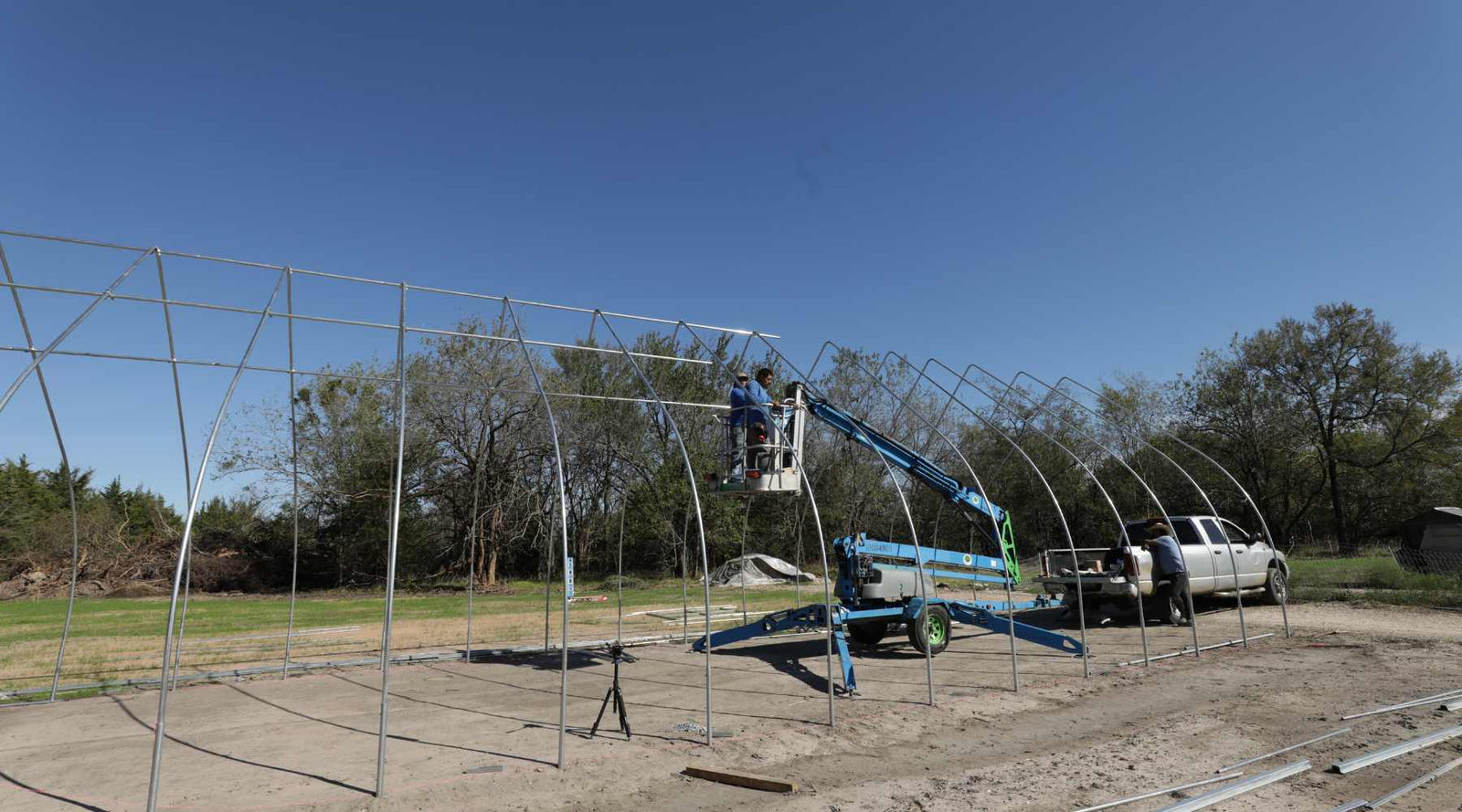Free Shipping on Orders over $75 to the Contiguous US
Free Shipping on Orders over $75 to the Contiguous US
Ground Posts and Hoops
May 14, 2023 5 min read 0 Comments

WHAT ARE GROUND POSTS?
Ground Posts are the poles that go into the ground to anchor the hoop house structure into the ground. Each pole works both independently as an anchor point and together as a connected structure. Ground posts are just slightly larger than the hoop pipes, and ¼" bolts are used to secure the hoops to the ground posts. The bolts must be on the inside of the plastic and run parallel and lengthwise to the structure. This protects the plastic from possible damage.
Watch the video!
GROUND POSTS ARE AN INTEGRAL PART OF HOOP HOUSE STRENGTH.
The strength and interior air volume in hoop houses are made possible to the millennia-old building shape, the arch. Pipes equally bent into roughly half circles are very strong, especially when properly connected. Arches evenly distribute weight and live loads (wind) to the ground posts and in turn the ground. The types of materials used to construct the hoops vary wildly depending on the accessibility of certain materials, the budget, as well as the farm's individual needs
HOW DO I INSTALL MY GROUND POSTS?
Ground posts are installed using a ground post driver. This is included in our hoop house kit. Ground Post Drivers are the tool to evenly pound in the posts without deforming the lip of the ground post. This is a specialty piece of equipment that is not found in hardware stores. The most common pole and what we provide is 4' with 2' in the ground and 2' out of the ground.
HOOP CONSIDERATIONS WHEN BUILDING A HOOP HOUSE
When placing your hoops into the correct width ground posts the hoops should be about 12" wider than the ground posts. As you place one side in one side of the ground posts a partner pushes in and sets the hoop in the other ground post. This spring loading of the hoops give them their strength and stiffen up the arch. Don't push the hoops in as far as you can, you will adjust the height before you install the hoop to ground post bolts.
When all of the hoops are installed it is very common for them to need initial leveling and plumbing. At this point it is best to have the keenest eye among you on a step ladder with eyes level with the top of the hoop. "Eyeballing" the hoops all the way down by pushing hoops in or side to side will get you close but do not expect them to be perfect. They all straighten up when you begin installing the hip boards, baseboards, and ridge poles for the hoop house.
The hoop benders are made to bend certain radiuses, and when bending the required amount of 10' poles (10' 6" with swag), they make the most accurate hoops for those instructions. In other words, both 10' and 12' benders both use 2 10' poles, but the radius of the pole bender makes completely different width structures with the wider house being a bit shorter.
Similarly a 12' pole bender isn't intended to "bend differently" to make a 14' hoop. Often the best tool is the one that was specifically designed to do a specific job.
Bending Your Own Hoops
The following statement is true for the entire build but mostly comes into play at this stage. Because all farms, skill levels, and tolerances are variable, hoop houses are designed to have some play in them. These are not swiss watches that are precise engineering marvels.
Hoop houses are rarely perfectly square, plumb or level. Do the very best you can, occasionally re-do mistakes when your gut tells you. Once the plastic is on tight all small miscalculations go away. This isn't permission to cut corners or skip steps. It's more of an "you'll be ok if you are off a tad". Learning to take farming tasks in stride now will do wonders for your agricultural career long term.
When comparing hoops in kits, it is also important to note the spacing of hoops. Some budget manufacturing have spacing up to 6' rather than the much stronger 4' spacing. An important difference when it comes to snow and wind loads.
MATERIAL OPTIONS FOR HOOPS
PVC PIPES/ Plastic
- STRENGTH greatly reduced by UV exposure
- Heavy and sustained winds can push a PVC hoop house structure to failure.
- Compounded expenses later in the cost and time to rebuild the structure
*Bootstrap Farmer recognizes the need to start on a strict budget, but encourages anyone considering this route to do their research. Check out What Materials Do You Need for a DIY Hoop House Build Project here.
EMT (Electrical Metallic Tubing)
- The thin walls of this material do not give you a lot of length to work with
- EMT makes great individual bed covers for microclimates
- Best for smaller projects
BOOTSTRAP FARMER KITS ALL METAL PRE-BENT
- Stronger gauge metal available in these kits
- Double and triple galvanizing, zinc coating, and proprietary coating from top manufacturers *Up to 5X the corrosion resistance than cheaper metal
DIY HOOPS
For DIY'ers, you can bend your own hoops with kits that require you to locally source the wood and metal to save on shipping costs by sourcing poles locally. The trade off is sweat equity of easily bending your own hoops with a hoop bender. The other trade off is these hoops are made by hand and can be slightly un-uniform. While this doesn't hurt the strength it is enough to bother the perfectionists among us. Poles bent from 1 ⅜ top rail found in hardware store chain length fencing sections often are 17-18 gauge thickness.
Some wholesale type hoop house suppliers offer lengths of 21'. While this technically is ok, remember that this is out of spec of the intended in hoop house applications.
WHERE CAN I BUILD MY HOOP HOUSE?
Hoop Houses can be built over existing beds, uneven plots, and hills. Read Ideal Greenhouse or DIY Hoop House Orientation for guidance on what direction to face the end walls of your hoop house structure. All of these on farm interpretations can be done as long as you figure in extra plastic for width/length. This is the beauty of using ground posts to anchor your structure. They allow you to flow over the land rather than trying to drop a flat bottomed structure on uneven ground. Be sure to account for any in ground obstacles that may impede ground posts depth, or make installation difficult by way of having to work on too tall of a pole. Again the most common pole is 4' with 2' in the ground and 2' out of the ground.
The comfort level you have in making modifications are part of a long line of decisions you will face running your own business. Kit instructions from any manufacturer act as a guide.
Guides work great, if everything is equal. Crops, climate, terrain, skill level of the farmer, and even physical considerations such as the farmer's height can be challenges requiring modification. These modifications, or "going out of spec" help to make the structure your own.
Subscribe
Sign up to get the latest on sales, new releases and more …
